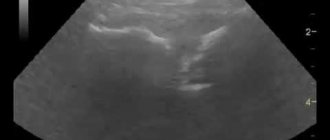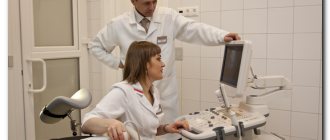According to indications, there are three dates when the first ultrasound is performed during pregnancy. This is a routine fetal examination in the 1st trimester and two additional sonographies. They are performed earlier in case of painful sensations in the abdomen or scanned later to clarify the results of the first ultrasound diagnosis. If a woman becomes pregnant using IVF, or she undergoes therapy, the frequency of ultrasound examinations becomes more frequent.
When will an ultrasound show pregnancy?
Ultrasound examination during pregnancy is an important procedure that can be used to determine whether conception has taken place, the exact date, and whether there are any abnormalities in the development of the embryo.
There are several types of ultrasound monitoring that are used by doctors depending on the purposes and functions required of the procedure. In early pregnancy, the study is carried out using two methods:
- Transvaginal. The most accurate examination technique used in the early stages of pregnancy. Using this technique, pregnancy can be determined as early as 3 weeks from the date of expected conception. Along with the examination, it is necessary to take a blood test to determine the level of hCG. And if the dynamics of hormone growth are observed, but no fertilized egg was detected during an ultrasound, then we can talk about an ectopic pregnancy.
- Transabdominal examination. The procedure is performed by placing sensors on the anterior wall of the abdominal cavity. At the same time, the accuracy of the examination is an order of magnitude lower than in the case of transvaginal diagnosis. In this case, pregnancy can be confirmed only 4-5 weeks after fertilization of the egg and successful implantation of the embryo to the uterine wall.
Why is it necessary to do an ultrasound early?
The purpose of ultrasound in the first weeks of pregnancy is:
- establishment of embryonic gestational age;
- diagnosis of multiple pregnancy;
- establishing the uterine localization of the fertilized egg;
- diagnosis of pregnancy complications (tone, threatening and incipient miscarriage);
- assessment of the yolk sac, chorion;
- assessment of the vital activity of the embryo;
- study of the size and structure of the fertilized egg and embryo.
Is it possible to do an ultrasound so early?
Almost every woman who is in an “interesting situation” is aware that throughout the entire period of bearing a child she needs to undergo 3 planned procedures. The goal is to determine the dynamics of fetal development and eliminate the risks of pathological abnormalities in the unborn child.
The first screening ultrasound, after which blood is drawn to analyze the dynamics of hCG growth, is prescribed for 10-12 weeks of pregnancy. But, as a rule, most women want to find out about the presence of a developing fetus as early as possible. And then the question becomes relevant: will this procedure negatively affect the development of the baby?
In fact, the ultrasound used during the examination consists of ordinary and harmless high-frequency sound waves that are not perceived by our hearing organs. The only thing that ultrasound monitoring affects is the uterus, which can become toned after the procedure. Therefore, if the uterus is hypertonic or there is a risk of miscarriage, then it is better to postpone a transvaginal ultrasound.
Advice! The question of when you can have your first ultrasound is best discussed with your consulting doctor. Doctors do not recommend unscheduled transvaginal ultrasound if there is aching pain in the lower abdomen, cramping and spotting.
It’s worth saying right away that conducting an ultrasound examination in the early stages of pregnancy has a number of advantages:
- confirmation of pregnancy test result;
- detection of ectopic pregnancy at an early stage, which avoids threats to a woman’s reproductive health;
- the ability to determine singleton or multiple pregnancy;
- assessment of the risk of miscarriage due to increased uterine tone;
- determining the most accurate time of conception.
What can you eat before the test?
Before an ultrasound, you need to exclude foods that contribute to the formation of gases in the intestines.
In fact, before the ultrasound, you are allowed to eat and drink at any time. Experts recommend that a woman avoid drinking drinks such as tea and coffee throughout her pregnancy. The fact is that they can affect the activity of the developing fetus, which can affect ultrasound readings.
A day before the procedure, it is recommended to exclude from your diet all dishes and products that can cause the accumulation of large amounts of gas or are poorly digested in the intestines. In addition, it is important to take into account the characteristics of a pregnant woman’s body. It is best not to eat sweet foods, legumes or drink carbonated drinks. All other foods are not only edible, but also necessary.
In fact, performing an ultrasound does not require any complex special preparation.
First of all, you need to make an appointment with an ultrasound diagnostic specialist. When visiting it, a woman must bring with her an exchange card, passport and insurance policy. In addition, you need to take with you a disposable diaper to cover the couch, and a napkin to remove any remaining acoustic gel.
Before a woman undergoes a transvaginal ultrasound, it is best to empty her bladder. In addition, it is not recommended to drink water before conducting such a study, since a full bladder will cause some discomfort to the woman. It is for this reason that before conducting an examination through the vagina, the patient should definitely go to the toilet.
Women often ask specialists whether ultrasound is harmful to the fetus. In fact, today such a study is considered the safest and most informative, and thanks to it it is possible to assess the condition of the fetus. It is completely harmless to the child and mother, so you should not refuse it.
When is ultrasound prescribed?
When to go for the first ultrasound? If, after a delay, a woman took a pregnancy test and it showed 2 stripes, then she needs to go to a gynecologist who will tell you exactly when to conduct the first ultrasound examination. Such a procedure is prescribed on a purely individual basis, taking into account all the risks and the need for examination.
If after a visual examination it turns out that the pregnancy is proceeding without complications, then the first ultrasound is scheduled at 10-12 weeks. True, sometimes testing is prescribed much earlier - at 4-6 weeks it is already clear whether pregnancy has occurred or not.
Common Questions
If pregnancy is suspected, patients seek answers to a number of questions. They are interested in:
- timing of the first ultrasound;
- reasons for discrepancies between ultrasound and dipstick results;
- correspondence of embryo size to gestational age.
Will an ultrasound show pregnancy before the delay?
You can find out about pregnancy a week after the delay occurs. However, a woman should be examined by an experienced doctor using the latest equipment. The approximate obstetric period for early diagnosis is 3 weeks. It would be informative to contact the clinic on the ninth or eleventh day of the delay. Doctors will perform an ultrasound using a vaginal probe. At this time, it is impossible to detect an ectopic pregnancy and the number of embryos developing in the uterus. The specialist must use the vaginal sensor carefully so as not to injure the unborn child.
When planning motherhood, a woman calculates the ovulation period using the calendar method. After a few days, the patient performs a home test, but a positive result is unlikely. You can use highly accurate (up to 100 percent) ovulation tests to help you plan your pregnancy. They increase the likelihood of conceiving a child.
The test is positive, but the examination is not, and vice versa
Sometimes doctors can confuse cysts of the inner layer of the uterus and polyps with a conceived child. This happens especially often if the patient’s blood test shows an increased amount of hCG. Levels of this hormone can increase even without pregnancy. This can happen due to ovarian diseases, hydatidiform mole during a previous pregnancy, or liver pathologies. Sometimes a three-digit amount of the hormone remains for some time after a miscarriage has occurred. If the unsuccessful pregnancy was early, the woman mistakes it for the beginning of her period.
A mother's visit to the clinic too early may result in a false negative result. After a few days, it is impossible to detect that an embryo begins to form in the uterus. It is also impossible to make a correct diagnosis if the blastocyst is attached to an inappropriate place, for example, in a tube.
If 1 week more than obstetric
The situation may indicate that the baby will be born large. Although the beginning of pregnancy is not very informative for predicting the future body weight of the baby. The mother should check herself and the embryo if the rapid test shows an existing pregnancy 7 days late. Two stripes should appear two weeks after conception occurs. If late ovulation occurs, then hormones begin to be produced with a delay.
When examined with an ultrasound sensor after late ovulation, even a good specialist may not see the fetus a week after the end of the menstrual cycle. The blastocyst later descends into the uterine cavity, so the pregnancy is not visible to medical staff. The doctor will issue a conclusion that the woman is not carrying the fetus. After one or one and a half weeks, during a re-examination, the doctor will see both the embryo and its structure. Late ovulation is determined only by size.
Indications for early research
An ultrasound examination already 10 days after the delay can show whether pregnancy has occurred or not. But this does not mean that such early diagnosis is indicated for absolutely all women. There are a number of indications according to which a doctor may recommend early testing:
- A delay in menstruation is accompanied by pain in the lower abdomen and spotting, which is not typical for menstruation.
- If a woman already has a history of early miscarriages.
- When menstruation is delayed, the test is positive, but neither visual examination nor palpation confirms the fact of conception.
- With previous operations on the uterus, including caesarean section.
- When there is no accurate data about the last menstruation.
Ultrasound diagnostics in this case will allow not only to determine the gestational age, but also the correct attachment of the fetus, whether there is a risk of VD, as well as possible pathologies in the development of the embryo.
If a surgical intervention was previously performed on the uterus, then with the help of a diagnostic ultrasound examination it will be possible to determine the condition of the postoperative scar and whether the embryo has settled in this area.
What is the price
Cost of diagnostics in different cities:
| Region | Price | Firm |
| Moscow | from 1700 rub. | "Miracle Doctor" |
| Chelyabinsk | from 700 rub. | Medical |
| Krasnodar | from 1000 rub. | "Clinic 112" |
If a woman is prescribed a screening examination (a complex of ultrasound and biochemical analysis of venous blood for hormones), the price will be slightly higher:
| Region | Price | Firm |
| Moscow | from 2400 rub. | Clinic "Medok" |
| Chelyabinsk | from 1400 rub. | Medical |
| Krasnodar | from 1800 rub. | Clinic "Ekaterininskaya" |
How is the procedure performed?
As mentioned earlier, there are two methods of conducting research: transvaginal and transabdominal. Most often, for early diagnosis, doctors turn to the first method, since it is more accurate.
The essence of the technique is as follows: a special device is inserted into the woman’s vagina, onto which a condom is first placed, which eliminates the possibility of infection getting inside the reproductive organ.
At the end of this device there is a camera sensor that records the state of the internal cavity of the uterus and transmits data to the equipment. As a result, on the screen we can observe everything that happens inside the uterus.
If, nevertheless, a transabdominal examination was prescribed, then you should know that it is carried out with a full bladder.
Methods of carrying out
For ultrasound diagnosis of pregnancy in the 1st trimester, 2 methods are used in obstetrics and gynecology - abdominal (through the abdominal wall) and transvaginal.
Diagnostics through the abdominal wall
Abdominal ultrasound is performed using a special convex sensor - a transducer, which can scan organs at a depth of 20-30 cm. No invasive methods are required, since all information is obtained from contact with the abdominal wall.
The first abdominal (transabdominal) ultrasound during pregnancy goes like this:
- The woman undresses to the waist or lifts her clothes in the abdominal area, and then lies down on the couch on her side.
- To obtain more reliable data, the sonologist lubricates the abdominal wall with a special gel. It allows you to increase the density of contact of the sensor with the skin.
- The specialist moves the device over the abdomen for 5–7 minutes. The data is displayed on a monitor and recorded by a computer.
The procedure is completely painless and does not require any effort from the patient.
Abdominal ultrasound
Sensor for diagnostics through the abdominal wall
Transvaginal method using a vaginal sensor
This type of study allows you to obtain more reliable data, since the sensor is in direct contact with the internal organs that are being observed. But, as a rule, transvaginal examination is prescribed only in the first trimester of pregnancy, because then it can cause uterine hypertonicity.
Transvaginal ultrasound proceeds as follows:
- The patient needs to undress from the waist down and then lie down on the couch on her back. Your knees should be bent.
- The sonologist puts a condom on a special sensor and lubricates it with gel lubricant for comfortable insertion.
- The doctor inserts a sensor into the vagina.
The procedure takes no more than 5–6 minutes. It does not cause any unpleasant sensations, because the ultrasonic sensor has relatively small dimensions (3 cm in diameter and 12 cm in length) and is inserted to a shallow depth.
After a transvaginal ultrasound, slight bleeding may appear the next day.
Photo of the transvaginal method
Sensor for transvaginal ultrasound
If pregnancy is not confirmed
So, from what period does an ultrasound show pregnancy, we have already found out. Now let's try to figure it out, is it possible that during the examination the embryo was not discovered inside the uterus?
There are several explanations for this:
- Very short gestational age.
- Outdated equipment
- Low qualification of uzist.
- Implantation occurred in a different place: fallopian tubes, appendages, peritoneum.
- There is no pregnancy, but the test result is false positive.
- Doctor's mistake. We are all human and everyone has the right to make mistakes.
If pregnancy is not confirmed during the study, then, first of all, you need to show the results of the examination to your consulting doctor.
When the presence of VD is excluded, after some time you can repeat the test and visit a gynecologist.
Important! An ectopic pregnancy developing in the tube is quite difficult to see in the early stages, so you should also pay attention to indirect signs.
Possible errors in ultrasound results
Despite the fact that ultrasound is considered one of the most accurate ways to determine pregnancy for a period of five obstetric weeks, there are cases when the device does not see the embryo or diagnoses a conception that does not exist. The reasons for the errors in the research results may be:
- Excess weight of a woman during transabdomial ultrasound. A large fat layer prevents the sensor from gaining full access to the object being examined.
- Broken or outdated equipment.
- Insufficiently qualified specialist conducting diagnostics.
- The presence of neoplasms (polyps, cysts) in the uterus, which the doctor may mistake for a fertilized egg.
A common situation is when the date of the last menstruation indicates five obstetric weeks, but the embryo is not visible on ultrasound. This happens in women with long menstrual cycles. The actual period at the time of examination turns out to be too short, and the sensor is not able to see the embryo.
It is believed that errors in determining pregnancy at its very beginning using ultrasound occur in one out of ten cases. Therefore, you cannot trust the results of the equipment 100 percent. You need to continue to monitor your condition and try other methods. If there are doubts about the quality of the equipment that was used or the competence of the specialist, you can undergo a re-examination.
Bottom line
At the end of this publication, I would like to add: in the vast majority of cases, early ultrasound is performed solely out of idle interest. If there are no alarming symptoms, then this is quite possible, but in the case when there is a nagging pain in the lower abdomen and uncharacteristic discharge, it is better to consult a gynecologist before an ultrasound examination.
Did you or your friends undergo ultrasound diagnostics only the required 3 times throughout your pregnancy, or were additional examinations prescribed?











